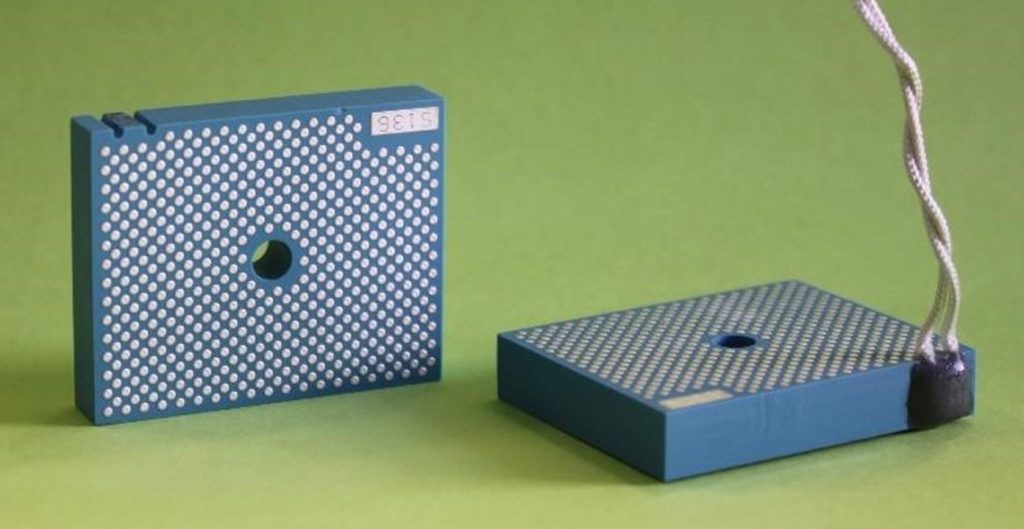As part of the efforts to facilitate the further use of fusion technologies in new applications, Fusion for Energy with the support of In Extenso Innovation Croissance operates an Open Call for Fusion Technology Transfer Demonstrator proposals. This 35 000€ funding opportunity aims at supporting a demonstrator project where a fusion technology is planned to be used in a non-fusion environment.
“Our ambition is to show how working with F4E stimulates innovation and creates new technologies that benefit European industries outside the ITER project. We are putting in contact companies, so they identify new business opportunities and develop new products and services based on fusion technologies, thus increasing their competitiveness.”
Carmen CASTERAS, Technology Transfer Officer, Fusion for Energy
Specialised in Low temperature co-fired ceramic multilayer substrates, the winner of the 2022 Open Call VIA electronic GmbH submitted a project that impressed the jury by its ambition and impacts in non-fusion markets. The idea in brief: adapting an interconnection technology applicable for high peak temperatures (up to 700°C) and developed for the ITER project to offer new competitive products for power electronics, LEDs and sensors applications. For the ITER project, VIA electronic has developed and manufactured LTCC sensor coils that will oversee local magnetic fields in various frequency ranges inside the Vacuum Vessel. Due to material properties such as advanced dielectric characteristics or non-magnetic materials, LTCC is ideally suited for use cases in harsh environment, low or high temperature, vacuum or high magnetic fields.
“It was challenging to deliver a high number of sensors with a tight schedule, pushing the manufacturing technology to the limits in terms of complexity and tight tolerances. But in the end VIA ELECTRONIC rose to the challenge and delivered a good product that we will be using for many years of ITER operation.”
Ulrich WALACH, Technical Responsible Officer for this project, Fusion for Energy

During one year and thanks to the funding secured for this endeavor, VIA electronic embarked on the journey to develop a dependable and cost-efficient copper wire interconnection technology, offering an alternative to the escalating cost of gold and to cater to the burgeoning demand for power electronics in automotive and LED applications. Especially, the German Company devised a meticulous manufacturing process to bond copper wire with LTCC (Low-Temperature Co-fired Ceramic) through several key steps: development of a copper (Cu) conductor deposition process on LTCC modules, determination of sintering conditions, rigorous characterization and evaluation of Cu metallization on LTCC, bonding of thick copper wires to LTCC substrates and then investigation into the impact of sintering in a N2 atmosphere on other metallisations.
“With this funding, we had a clear idea on how we wanted to evaluate the feasibility of copper interconnection technology with Low Temperature Co-Fired Ceramics and adjust our technology to the requirement of new markets.”
Uwe KRIEGER, R&D Project Manager, VIA electronic GmbH

However, this undertaking proved more challenging than anticipated. The first hurdle involved identifying the appropriate conditions for copper printing and sintering, requiring preliminary tests to prevent oxidation, peeling, or warping. Once the ideal conditions were ascertained, the printing process was executed using various pastes and substrates to evaluate the most appropriate. Subsequently, gap welding process with copper wires was developed together with Fraunhofer IKTS (Dresden) to achieve high power compatible connections, and tensile strength tests were conducted to ascertain the correct parameters.
An essential final task entailed evaluating the compatibility of the copper metallization with the co-firing materials, such as silver. Both copper and silver were subjected to sintering at temperatures exceeding 900°C, but direct contact and reaching their eutectic point (<<900°C) have to be prevented. In response to this challenge, VIA electronic evaluated various innovative approaches, including the incorporation of additional diffusion barriers, or reducing the post-fire temperature of paste below the eutectic temperature. This efforts resulted in successfully connected Ag and Cu current lines that brings the technology closer to the market.
“Thanks to this demonstrator funding, VIA Electronic achieved tangible results and expanded both its manufacturing know-how and competitive advantage, particularly regarding the connection of silver conductor lines in standard LTCC with copper based connections for high power electronics. We have also been able to present our results at various exhibitions such as EUMW 2022 or the iMAPS meeting in Munich.”
Harald KLAUBERT, Business Development Manager, VIA electronic GmbH